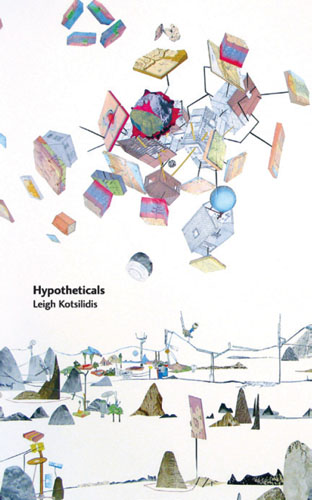
This Article From Issue
May-June 2012
Volume 100, Number 3
Page 264
DOI: 10.1511/2012.96.264
HYPOTHETICALS. Leigh Kotsilidis. 95 pp. Coach House Books, 2011. $15.95.
We live in a postsecular age. Religion, surprisingly to some, is on the rise. Western science, meanwhile, is on the ropes, experiencing a backlash fueled by a wide dissatisfaction with the Galilean notion that science is the sole means of ascertaining the truth.

Nor is everyone who questions science today doing so from the standpoint of religious faith or fanaticism. In a time when intelligence is popularly equated with a science-centric view of the world, very intelligent people are evolving a new vision. Leigh Kotsilidis’s first collection of poems, Hypotheticals, is a wonderful window into the mind and soul of a poet whose generation, highly educated and steeped in science, is challenging the constructs that have filled the void left by reason’s triumph over faith.
Kotsilidis’s poems, one by one, deconstruct our certainties, poking holes in both our expectations and ready explanations for the world around us. These are certainly not poems that propose a balm of religious faith. They are poems that refuse to accept faith in science. Their speakers describe things as they are experienced, as they happen, in series of disjointed images and randomly connected thoughts and responses. If these images seem to be in search of gestures in the natural world—some kind of cohesive orchestration—they also appear to be moving within an integral system beyond our full understanding. The big force that befuddles our scientific perception in Hypotheticals is nature itself. From “Almanac”:
You were expecting . . . what?
. . . . . . . . . . . . . . .
700,000 decibels of air
will barrel through by morning.
This range will shift in tiny increments
to a new location. You cannot rely
on maps.
The poems bring a cold analysis to bear on the world at large, and the descriptions within them will surprise readers much more often than connect with them on the level that Duke Ellington cherished—the thing that is said without saying it. In short, Kotsilidis’s work seems to challenge the precepts of poetry as avidly as it takes on science. Rather than Ellington, she might be compared with Ornette Coleman.
That said, Kotsilidis does not entirely avoid the primary pitfall of poetry about science and poetry written by scientists: placing a learned-about phenomenon that is impossible to experience via the senses on the same level as a visually perceived sensation. This tendency sometimes appears in the form of a lecture, as in the opening lines of “Ambitious Birds”:
As certainly as rain runs down a cheek,
runways run below the airplane window,
molecules part, relocate, reform.
The sympathy I gain for this poem in the first two lines—my feeling that I am about to take off with it—drops like a rock in the third. The beautiful connection of the teardrop’s trek with the runway rolling under the plane is thrilling on the level of shared experience. But I don’t share the speaker’s vision of molecular relocation. I don’t believe she has experienced molecular relocation. Rather, I assume she has only learned about molecular relocation.
The book has more than a page of notes. Purists would insist that a poetry collection should have no notes other than a few well-placed epigraphs or date lines, and I tend to agree. Kotsilidis credits Wonders of Numbers: Adventures in Mathematics, Mind and Meaning, by Clifford A. Pickover, for an epigraph in one poem, and the Wikipedia entry for the Animal Planet network’s documentary series The Most Extreme for a response to an interviewer in another poem (I do like her interviews and dramatic exchanges). What this volume lacks in literary allusions, it makes up for in obscure, hip or wonky references—ones that really do require footnotes.
Although received formal elements are mostly absent in Hypotheticals, Kotsilidis handles the difficult form of blank verse masterfully in “Flight School.” Her use of iambic and trochaic heterometrics (lines of varying numbers of feet) in “The Proof Is in the Pudding I,” “Almanac” and elsewhere is really impressive. And the book includes several list poems. She is a sly formalist! I was less pleased, however, by Kotsilidis’s flip use of internal rhyme, which persistently registers as ironic but does not exploit the full potential of the strategy. Also unfortunate is her penchant for puns such as “some unhappy heifer after,” which closes out the poem “Rodeo Romance.”
Still, Kotsilidis’s diction is crisp, her turns of phrase quite sharp. Her poetry maintains a certain integrity. The associative-dissociative swing of “The Way the Cookie Crumbled” is pure joy. And many of the poems have real music, especially the ones that convey ineffable personal experience, such as “Nouveau Riche.”
This book is not for every reader—a non-poetry-reading scientist might be more taken with it than a non-science-oriented poetry reader—but it has much to offer. Kotsilidis writes novel verse that holds a tension between the free and the formal. I imagine it is quite engaging when performed aloud. Moreover, it seems to represent the best—which is to say, the smartest—in a new kind of poetry, steeped in science, relentlessly questioning its foundation (examination of the spine is a recurrent trope) and hardly concerned about where that leaves poetic tradition. Hypotheticals proposes a new look at the world in a brave poetic voice.
Rick Mullin is a senior editor at Chemical & Engineering News. His epic poem, Soutine, on the life of the Russian painter Chaïm Soutine, was published this year by Dos Madres Press. He is the author of the poetry chapbook Aquinas Flinched (Exot Books, 2008) and the book-length poem Huncke (Seven Towers, 2010).
American Scientist Comments and Discussion
To discuss our articles or comment on them, please share them and tag American Scientist on social media platforms. Here are links to our profiles on Twitter, Facebook, and LinkedIn.
If we re-share your post, we will moderate comments/discussion following our comments policy.